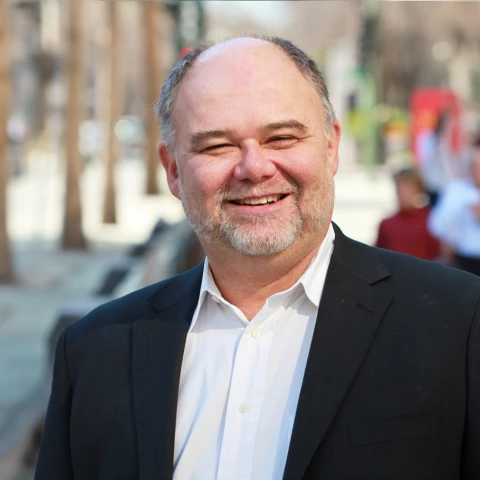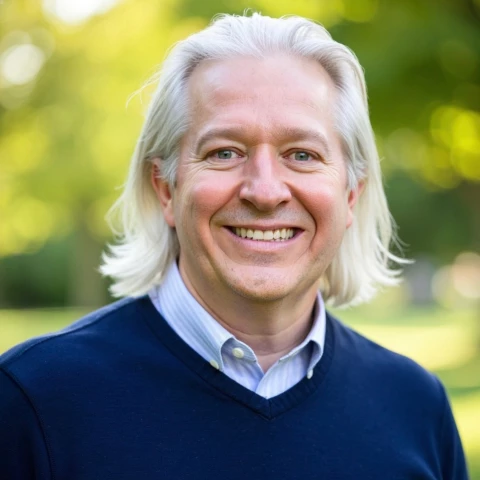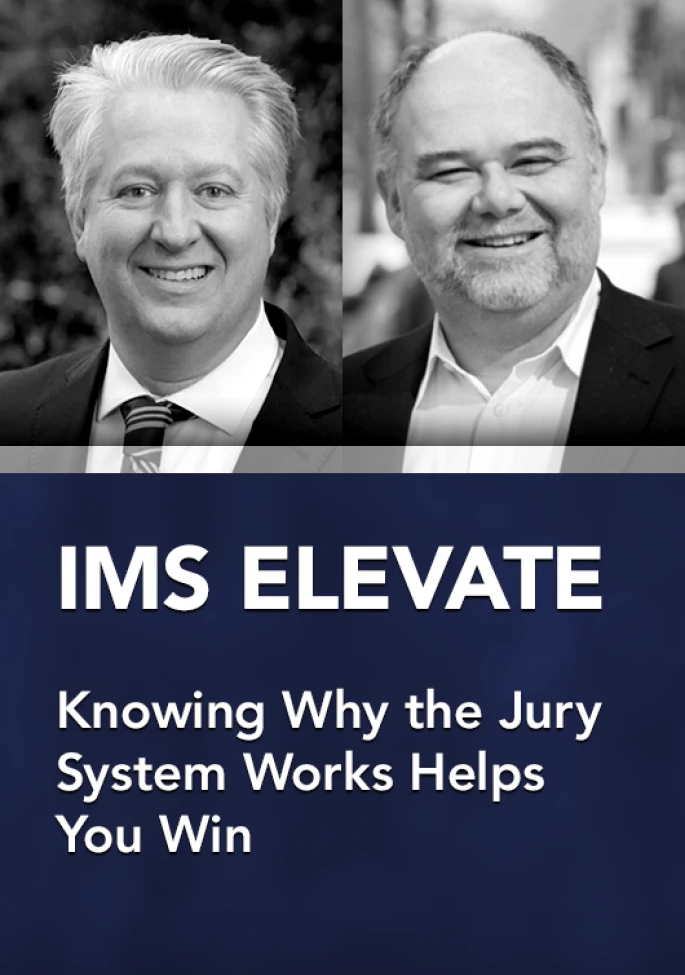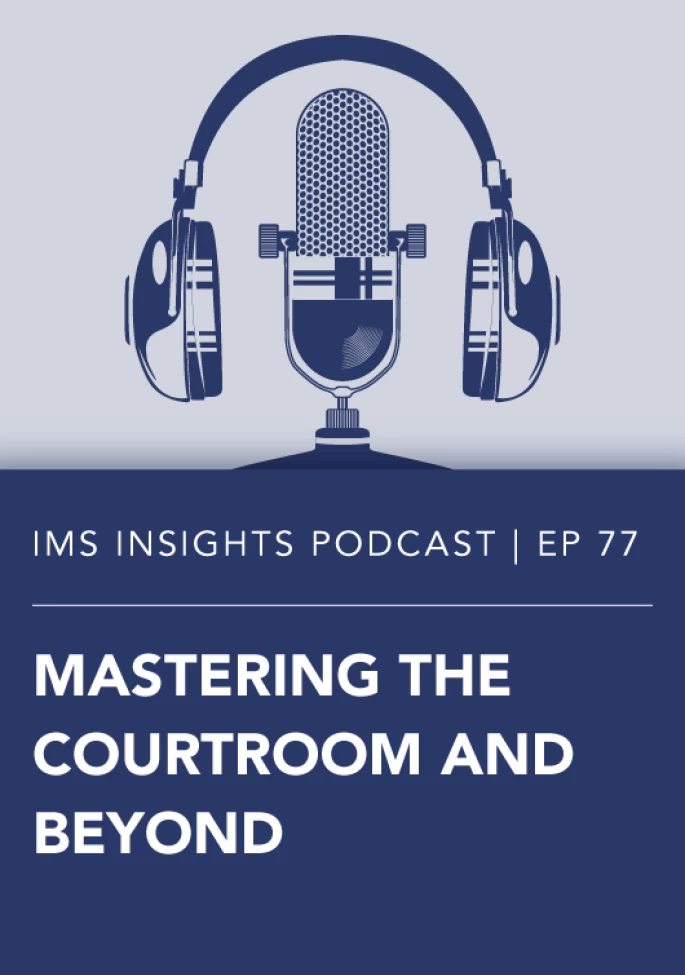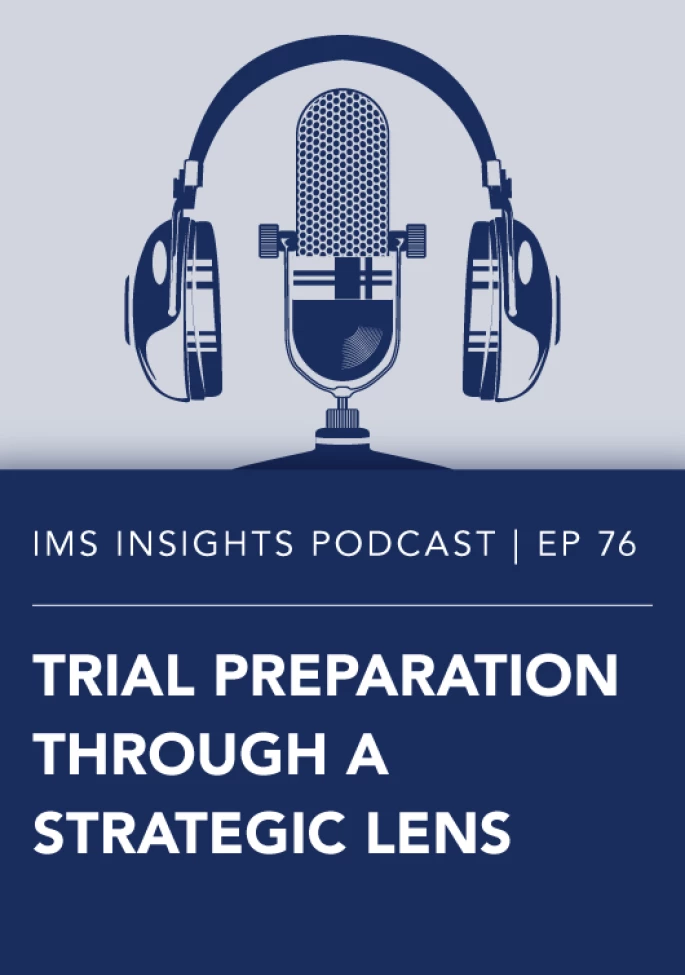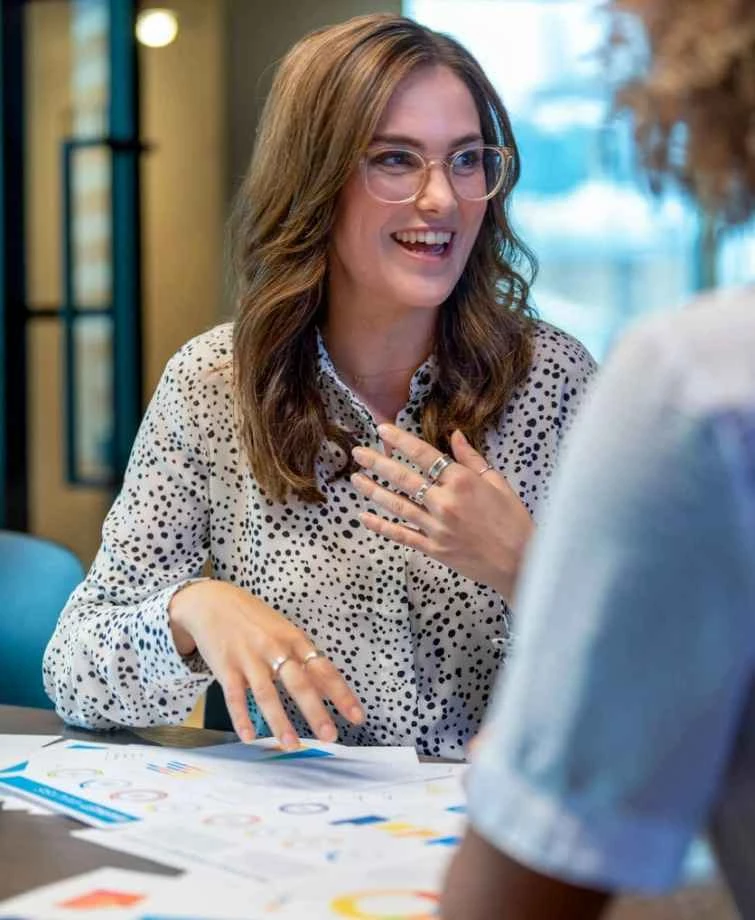Transcript:
Laura Clementi (Intro): Good morning, everyone, I'm Laura Clementi, a Solution Advisor here at IMS. Today we're joined by Chris Ritter, who is one of the nation's leading authorities on jury persuasion and trial strategy. Chris helps us unpack how juries really make decisions, what drives their reasoning, how coalitions shift during deliberations, and what attorneys can do to become more effective teachers. Leading our discussion is my colleague Adam Bloomberg, a Senior Client Success Advisor here at IMS.
Laura: Hey, Adam.
Adam Bloomberg: Hey, Laura.
Laura: Handing off to you.
Adam: Thank you so much. I appreciate it. Chris, thank you so much for joining me today. Let's start with something basic. How do jurors reach a verdict?
Chris Ritter: All right. Well, I think first of all, there are a couple things that you need to know that are important. First of all, in most jurisdictions, there's a requirement that you be unanimous and in all jurisdictions it must be at least by some super majority. So that requires deliberation.You can't just have the first person to get 7 out of 12 votes wins. The other thing you have to understand is that they end up agreeing on an answer. They don't necessarily agree on the path they got there and to the extent that they want to get to that answer, here's typically what happens. They form into three groups, initially pro plaintiff, pro defendant, and then an undecided group. And usually within each of the pro, the pro plaintiff and the pro defendant drew upstairs what I call an active juror who's really wants to see that side win. There can often be more than one. And they will go through a process of forming coalition so that people will ultimately agree on the answer. That's why it's a coalition, but not necessarily agree on the reason they get there. And they'll keep doing that until they ultimately have the 12 or the 10 or whatever is statutorily required within the jurisdiction.
Adam: Now, you mentioned one of the key aspects of the jury system, and that's requiring A unanimous verdict or a supermajority, depending on the venue. Why is this requirement important and how can attorneys leverage it at trial?
Chris: You have to remember, you know, the issues that we give to jurors are some of the most important issues that we face as society. And they're certainly, for the two parties involved, the incredibly important issues. I don't think anyone would trust a system where you would just have a snap decision, whoever got the majority, 7 out of 12 votes, for example. We want people to deliberate. We force them to deliberate by having these numbers of unanimous or super majority. They have to come up and spend time talking with each other. It forces the majority to listen to the minority. And so it really results in a real thorough analysis before the verdict is is reached. Now, as far as lawyers influencing them, I think it's important for the jurors to keep, for the lawyers to keep in mind that jurors will take different paths to get to the same answer. That's what we're looking for. We're not looking for, however, you to come up with a million different paths. But we do recognize there are certain things like core values, there's certain things that allow you to kind of tailor a series of options and make it available so that jurors can use different paths to get to the same answer. And allow the active juror, the person who's fighting for that from the very beginning, to use those same tools to convince people that that answer is the correct one.
Adam: Yeah, I heard you in a recent ABA presentation say that the jury system works because jurors take their role seriously. How does that mindset influence the decision making process? And what can attorneys do to ensure they're seen as credible by the jurors?
Chris: You know, I think sometimes people are very cynical about the jury system. They they, they wonder how seriously jurors take the take what they do. And anyone who served on a jury, anyone who spent time with jurors, anyone who's done research on jurors find that the vast majority of them take their job very seriously. I mean, after all, we are asking them to give up a lot to come in and be jurors. They're they're not working, they're not getting paid for the most part. They're having to give up time. They're having to decide issues for people they don't even know. I mean, it's a real burden. What I think is reassuring is that people take that burden seriously and they want to make sure that they do the best possible job, in fact, the best result. The thing they want most is to feel that they have come to the right decision. So I think lawyers can do two things. One is to provide them with the tools they need so that they can come to that right decision and quite frankly, not waste their time. They're there on their own to, to, to giving up time. And lawyers need to make sure that when they present the case, they do it in a way that doesn't waste time. It gets right to the issues and gives people what they need in order to make the decision.
Adam: So let's shift gears a little bit. Let's talk about teaching. There are several opportunities for trial lawyers in, in opening and closing through witnesses and evidence. How can attorneys make the most of these opportunities to ensure their message resonates with the jury?
Chris: Well, I think the first and most important thing is for lawyers to recognize trial lawyers, to recognize that the best trial lawyers are teachers. I mean, they use techniques that teachers use to help explain and, and provide information. So first I think you need to do is you need to recognize that you're there to you're, you're there to help teach. The other thing is, you know, every single speech rhetoric class you've ever taken, at least for me, starting in line of 5th or 6th grade, we always got the same advice. Tell them what you're going to tell them. Tell them and then tell them what they told, what you told them. And I'm her, I hear that that traces back to Aristotle and rhetoric. I don't, I don't know whether that's true or not, but it's great advice and it, and it lingers because it is great advice. Think about the trial. We actually divide our trial into 3 sections, each one of which corresponds to one of those suggested ways of persuading the opening statement. We tell them what we're going to tell them. The case in chief, we tell them. And in closing argument, we tell them what we told them. It's important to keep that in mind as the basis of what you're doing, but also to recognize that each of those, each of those is an opportunity and each of those is an opportunity to do it in a slightly different way, using different tools and using different approaches. And combined all together, you get that three triumvirate that really does add for a real convincing, convinces the jury that they should reach a particular verdict.
Adam: You mentioned that jurors process information, and I think you said 3 three ways heuristically, systematically, and then the third would be kind of a combination between the two. How can trial attorneys adjust their presentation to apply to these different processing styles?
Chris: Let's define them heuristic. The ways that people process heuristically is they, they process using mental shortcuts. They have certain, certain set answers that they that they tend to rely on. The systematic jurors are the ones who will be much more detailed and go into and look for the the, the details of the case. The two really, I think the most accurate thing is that we we do both, but I never heard to basically provide heuristic ways of reaching people such as analogies, generalities, things that people can relate to from what they've known, values, themes, those kinds of things that they can relate to. But it's a courtroom and they have to back it up with something, right? And you need to be able to sustained in somebody's mind, not only that they have come and reached a decision, but the reason for doing it. So I think ideally what you're doing is you're providing a combination of general themes and theories and things such as that, that will appeal on the broad basis. And some of them may be, some people may, that may be all that they appeal to. But at the same time, you're also providing information in detail, clearly and concisely, so that people who want to know the detail can spend the time on detail, are able to do it and do it in a successful and meaningful way. And recognize those two often combine. So if you have both, you, you can't hurt.
Adam: Yeah. You discussed the importance of providing cobblestones for multiple roads to a single verdict. How do attorneys help jurors reach the same decision even if they initially start with a different point of view?
Chris: Yeah, well, I, I, let me, let me define a couple things here. When I talk about the paths that lead to a decision, that is something I mentioned before, which is the jurors agree on the conclusion. They don't always agree. In fact, rarely do you unanimously get them agreeing on how they got there. So I advise people to think as if they are preparing a variety of different paths, getting to the same same answer. And what you're going to be using there are you're going to be appealing to various core values. You're going to be appealing to various some of the teaching tools that we're using, some of the teaching tools that I talked about to basically give them what they need to not only jump onto that path, but stay on that path and then ultimately end up in the same place. Now, when I use cobblestones and I don't know, maybe it's, maybe I took the analogy too far, but that road is not just a single slab. It is made-up of a variety of different things that include different facts, include different arguments that include different theories, various things that people will pick up and use to essentially make that path that will take them ideally to the same conclusion, which is your conclusion.
Adam: Coalitions within the jury can shift during deliberations. It's not always clear how. So how can trial attorneys best prepare for and anticipate shifts in juror alliances that may affect the outcome of a case?
Chris: Well, I always tell people, if you, if you don't get a chance to sit on a jury or if you don't get a chance to watch a mock jury deliberate, go watch 12 Angry Men. And it's not perfect, but there's a really good job of seeing that alliance as you, as you, the coalition, as you say, develop and and shift. I think what we can do as trial lawyers is to, to, to recognize that the coalitions are for the most part, driven by a group of people called in my, what I call them, as active jurors. They're the ones who've made the change from neutral Finder of fact to ultimately advocating for one side or the other. You want to make sure that those people have the tools they need to not only understand and argue, but to keep arguing your case and to address what may be presented by the other side. I've seen so many cases where both sides are going after each other. You have a strong plaintiff, you have a strong defendant, and then quite frankly, the one side just runs out of ideas, runs out of answers to questions, and there's just a an abandonment of that side. So provide them with the tools they need, arm them with the tools they need in order to be able to effectively argue at multiple levels using multiple core values as to why your site is the winner.
Adam: So for attorneys considering bringing in a jury consultant like yourself, shameless plug, I know, what specific benefits do you bring or maybe your colleagues to the understanding and navigation of the jury system?
Chris: Yeah. And let me, let me, let me .1 thing out. I don't really consider myself to be a pure jury consultant in the sense that I don't have the, the social science background. But what I do have is having tried cases and taught trying cases, I consider myself to be a very effective persuasion consultant, which is one of the necessary elements of, of jury consulting, right. I think what you're going to be looking for is you're going to be looking for somebody who's got a major amount of experience that has been through a lot of different trials. Because one of the things that I do in mental mining is to effectively say, look, I've heard that argument before. Let me tell you how it's played in the past. So, I think you want that kind of experience. I think you want somebody who's got a broad knowledge and a good understanding of human nature and how human nature works. And I think it doesn't hurt at least, and I'll be shamelessly plugging it. If you've got somebody who has not only been a lawyer, but has been in the seats of the people who are asking for the assistance, I make it very clear to them, I'm not the I am a lawyer, still a lawyer, but I'm not the lawyer in this case. What I'm here to do is to help provide a slightly different perspective, maybe a, a a little more distance perspective than your you and your team have because you've just spent the last two years getting to know all the incredible details. That's what I think you're looking for.
Adam: Well, Chris, thank you so much for joining me today. It's always a pleasure.
Chris: Well, thank you, Adam. I always enjoy talking with you as well. So thank you for having me.
Adam: Take care.
Adam (Outro): IMS has served trusted law firms and corporations worldwide for more than 30 years and over 65,000 cases. As a strategic partner for the full case life cycle, our integrated teams provide specialized advisory support, expert witness services, litigation consulting, visual advocacy, and presentation technology to elevate strategies and protect hard-earned reputations. Learn more at imslegal.com.


